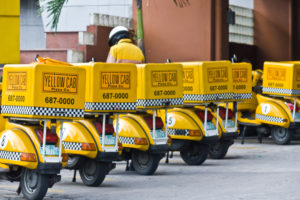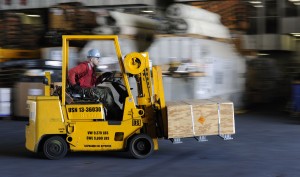 One-piece flow—while often defined differently—is one of the True Norths in lean manufacturing. Get your material flowing! In theory that is easy. In practice, however, there are many obstacles standing between where you are and where you want to be, also for one-piece flow.
One-piece flow—while often defined differently—is one of the True Norths in lean manufacturing. Get your material flowing! In theory that is easy. In practice, however, there are many obstacles standing between where you are and where you want to be, also for one-piece flow.
Introduction

As I wrote in a different post, one-piece flow moves each product to the next stage as soon as it is completed at the previous stage in the value stream. The next stage should be ready to accept the part immediately. The goal is to increase the time your material is being worked on or being transported, and reduce the time it is merely sitting around (with the caveat that transport is also one of the seven types of waste [muda] and should be reduced).
One famous example is Chaku Chaku lines, which work best if there is, at most, one piece between the processes. Reduced handling often makes such lines quite efficient. Such Chaku Chaku lines are close to the ideal for one-piece flow. There is a short time when the part rests, but for the sake of machine utilization, this is usually acceptable for Chaku Chaku lines.
How to Approach One-Piece Flow

Since the goal of one-piece flow is to always have parts either in production or moving between production steps, there are a few main levers. Some of these are obvious, others may be not.
- Make your transport unit smaller. Ideally you transport a single unit as soon as it is done.
- Have sufficient transport capacity, so that the part does not have to wait for transport.
- Avoid batch processes. If you make multiple parts in one batch (e.g., an oven for heat treatment), you will get many parts at the same time when the process is done. Chances are, at least some of the downstream processes are either not batch processes at all or at least have a different batch size, and—bang—you have parts waiting for the next step, breaking the flow.
- Do not overload your system. The next step should be ready to accept the next part without delay.
Some of these above approaches may be difficult. Some may be unachievable (e.g., it is unavoidable that a part sometimes just has to wait for a process or a transport). This is only the direction of True North, and it is up to you how far you are willing to go in this direction this time, and how much more next time. If you intend to go from your current state all the way to perfection in one step, chances are good you’ll kill your company. Let’s have a look at the possibilities and the trade-offs.
Small Transport Unit

The first step here is obvious. Transport a part whenever it is ready. If you have the choice between a big box/pallet/container/truck and a small one, tend toward the smaller one. Toyota in Japan prefers smaller but more frequent trucks over larger and less frequent ones.
If you present this to cost accounting, be prepared for some heated discussions, though. The transport cost can be easily calculated. The benefit of more frequent transport, however, is harder to calculate, and hence often ignored. But it IS there!
It can help if you put the processes closer together. This applies both to plants (Toyota’s main suppliers are within two hours of Toyota City) as well as to lines and processes. The farther apart they are, the more hassle it will be to transport, the more the tendency to bigger shipments.
Enough Transport Capacity

To keep material flowing, you need the ability to transport it. This is easiest done with dedicated systems like conveyor belts, AGVs, FIFO lanes, or similar. In this case you can also limit the inventory more easily, which prevents accumulation of material and reduces your flow.
It is a bit trickier with shared transport like forklifts or trucks. Having too much idle transport capacity costs money (which can be calculated easily), and you have to see if it is worth the reduced wait of material and processes (which is harder to calculate). Similar to the overloading of processes (see below), a 100% utilization of your forklift simply means that everything has to wait for transport and material will be piling up again.
Avoid Batch Processes
 You may or may not have batch processes that produce multiple parts at the same time. If you do, it is probably because cost accounting determines that it is cheaper that way, again overlooking the benefit of one-piece flow.
You may or may not have batch processes that produce multiple parts at the same time. If you do, it is probably because cost accounting determines that it is cheaper that way, again overlooking the benefit of one-piece flow.
I usually find that managers struggle quite a bit to imagine an alternative to such batch processes. It is not easy. But it is doable. For example, one-piece flow induction hardening can replace a conventional oven. I have written a whole post on how to achieve lot size one and eliminate batch processes, including aluminum die casting, for example.
Do Not Overload the System

Many shop floor managers dream of 100% utilization. However, this dream is usually a nightmare! As utilization approaches 100%, the lead time approaches infinity (for more details, see the Kingman equation). In other words, the higher the utilization, the more parts have to wait so that the process can always be busy. Often, utilization has a higher priority in factories, but this is due to cost accounting. Cost accounting can determine the investment cost of the machine very well, and hence tends toward 100% utilization to “get the most out of the machine.” However, they usually don’t realize that this drives up inventory and lead time. Even if they do, it is hard to put a monetary amount on all the negative effects of inventory and increased lead time.
Utilization is also only one of the aspects in the picture. Closely related is the balancing of the different processes. If one process is significantly slower or faster than the other ones, chances are good that material will accumulate before or after this process respectively. The closer the process speed matches the customer takt, the better your chances that you only have to deal with random fluctuations in speed rather than a permanent offset.
Can You Achieve Perfection?
No!
You can’t.
No matter what, sooner or later you will put a part down and have it wait for something else. That is life. You may not even want to achieve perfection. The closer you get to one-piece flow, the more other costs may rise. For example, for one-piece flow it would be best if you have many more machines than needed, so a part never has to wait. However, the capital investment would be abhorrent. You have to find a trade-off between machines waiting for parts and parts waiting for machines.
Similarly, for all the other approaches, there is usually a trade-off involved. Find a good trade-off, and in case of doubt, put more value on one-piece flow. But also keep in mind that the system is not static. You can change the system so that a better one-piece flow is possible and feasible. Putting machines closer together, improving the machine balancing, swapping a batch process for a process making parts one by one, … there are many ways to change the system to make one-piece flow more feasible. Now, go out, improve your system, get your parts flowing, and organize your industry!
PS: Also, on a side note, this is my 500th post on this blog. I am quite happy how a little side project that I started ten years ago turned out to be. Thanks for reading 🙂


Hello Prof Chris,
Thanks for the Post
This is definitely Good Reminder , especially for us in Indonesia that have job orders condition
A lot of company seems like Utilization or OEE as KPI Measurement
” We must find trade off between machines waiting for parts and parts waiting for machines ”
Once again thank you for the reminder
Good article
Thanks for this post and congratulations on your 500th!
Congrats Christoph for 500 👍
Comhghairdeas (congratulations) Chris on the 500th Post… In a world of digital transformation it is great to see Lean Thinking is still alive and well.
Congratulations! excellent article. Accumulation, in batch production, brings more chances the product gets damage and make more difficult to the operator to catch mistakes.
Congratulations, Chris, on your 500th post.